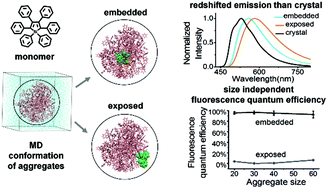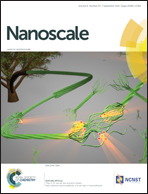Unraveling the aggregation effect on amorphous phase AIE luminogens: a computational study†
Abstract
To achieve the efficient and precise regulation of aggregation-induced emission (AIE), unraveling the aggregation effects on amorphous AIE luminogens is of vital importance. Using a theoretical protocol combining molecular dynamics simulations and quantum mechanics/molecular mechanics calculations, we explored the relationship between molecular packing, optical spectra and fluorescence quantum efficiency of amorphous AIE luminogens hexaphenylsilole (HPS). We confirmed that the redshifted emission of amorphous aggregates as compared to crystalline HPS is caused by the lower packing density of amorphous HPS aggregates and the reduced restrictions on their intramolecular low-frequency vibrational motions. Strikingly, our calculations revealed the size independent fluorescence quantum efficiency of nanosized HPS aggregates and predicted the linear relationship between the fluorescence intensity and aggregate size. This is because the nanosized aggregates are dominated by embedded HPS molecules which exhibit similar fluorescence quantum efficiency at different aggregate sizes. In addition, our results provided a direct explanation for the crystallization-enhanced emission phenomenon of propeller-shaped AIE luminogens in experiments. Our theoretical protocol is general and applicable to other AIE luminogens, thus laying solid foundation for the rational design of advanced AIE materials.


 Please wait while we load your content...
Please wait while we load your content...